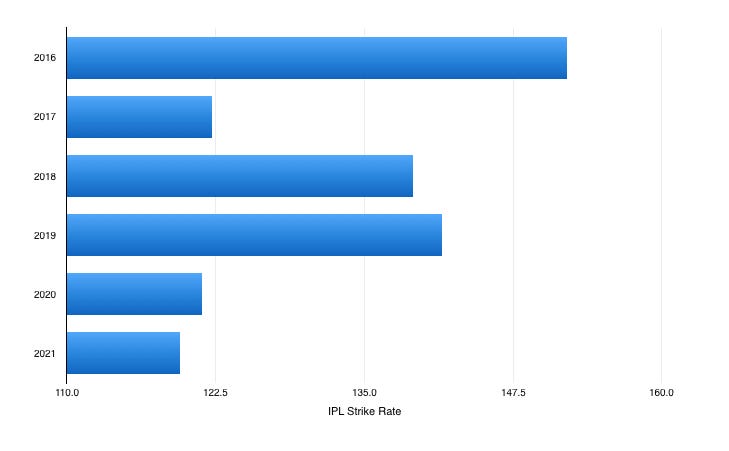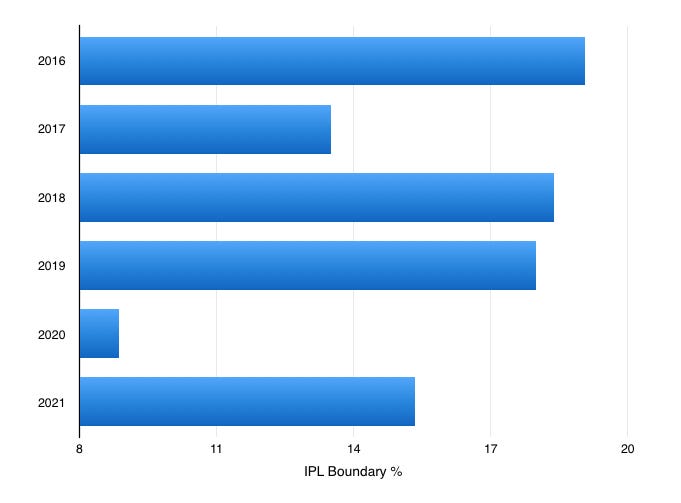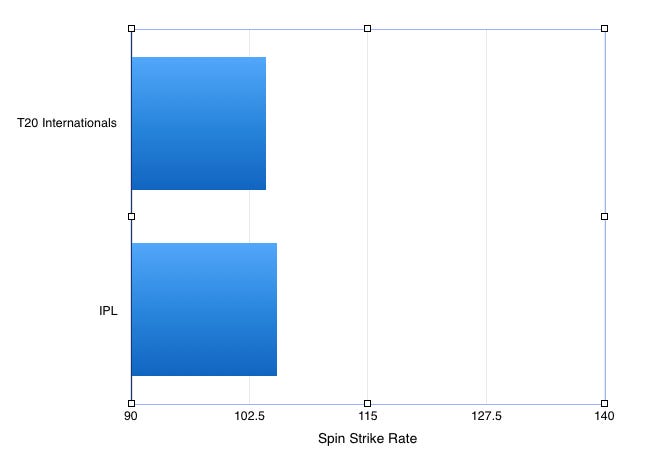India's Questionable Batting Strategy against Pakistan
It's time to talk about Kohli versus spin
As the World Cup progresses, I’ll be posting some regular content on here discussing the strategies adopted by teams in both success and failure. Today, we have to talk failure, both via the end result and process - in the biggest match of the tournament so far, India v Pakistan.
After a stunning opening burst from Shaheen Shah Afridi - the best left-arm pacer in World T20 cricket, be in no doubt about that - India were on the back foot immediately, reduced to 6-2. Virat Kohli and Suryakumar Yadav stabilised the innings initially, before Kohli and Pant got India to 84-4 with 46 balls of their innings remaining when Pant was dismissed.
Stabilising the innings after the two early wickets isn’t a disastrous strategy, but continuing to do so in the second half of a team’s innings when three or four wickets down is much more questionable. When a T20 team bats first, they have a number of known factors in order to try and establish what a decent score batting first is - a couple of key factors are listed below:-
1) Toss bias. If 70% of teams chasing win a match at a given venue, then the average score batting first should not be par. The average score would simply give you a roughly 30% chance of winning.
2) Opposition batting dynamics. Teams must consider the batting strengths and weaknesses of their opposition when considering what a good total is when batting first.
Anyone who has done research into the likely conditions in the UAE (and I hope that India have done this, although I’m not convinced based on their approach) would know that in the night matches, batting second has a big advantage due to the onset of heavy dew in the second innings, making it tough for bowlers to grip the ball. Because of this, it’s much easier to bat second than first, so teams batting first need to take more risks as a result - they need a bigger score to be at par or ahead of the game at half time.
Furthermore, Pakistan’s team are completely set up to chase low-medium type scores (130-160 ish totals), with both openers, Mohammad Rizwan and Babar Azam, being masters of these type of chases, as I tweeted at halftime in the match yesterday:-

So, in advance and during their innings, India needed to take both factors into account. The dew making it tough for their bowlers in the second innings (and therefore, easier for Pakistan’s batters), and also that to put any type of pressure on Pakistan, they had to target 165+ at a bare minimum.
With 46 balls left, if India targeted two runs per ball, they’d score 92 runs from the bat, plus extras, from 84-4, getting them up to around 180 if they were able to achieve this - this had to be the objective considering the known factors of the dew and opposition batting dynamics.
But, they didn’t. Jadeja, and in particular, Kohli, seemed happy just to knock it around for singles, and in some cases, pat the ball back to the bowler for dots. It was a strategy which made absolutely no sense, particularly considering India had one of the most devastating finishers in world T20 cricket, Hardik Pandya, waiting to bat.
Innings like Kohli’s (he scored 57 in 49 balls) tend to polarise opinion. Old-school observers (a lot of ex-players are included in this) tend to overvalue these type of innings, while analysts will focus on the fact that he used 40.83% of his team’s resources for just 57 runs, and scored just 6 boundaries in those 40.83% of team balls faced. Given that we know that around 85% of teams with the highest boundary percentage in the match win, choosing such a negative approach is akin to knowing that a coin will land on heads 85% of the time and then choosing tails.
This type of innings has become more commonplace from Kohli in recent years, particularly in the IPL - the chart below shows his IPL strike rate across the last six seasons:-
A similar story can be told from Kohli’s boundary percentage during the same time period:-
Yes, you aren’t mistaken - he hit around 9% boundaries in 2020 in the IPL. Around 16-17% is about average for the tournament in recent years. These figures are an issue, considering we know that teams almost always need to hit more boundaries than their opposition to win matches.
I guess what I’m trying to say here is that I’m unconvinced Kohli’s approach would have been markedly different regardless of the situation in which he batted in. In recent years in particular, he’s shown a real lack of intent against spin bowling in T20 cricket, and that manifested itself again yesterday (he scored 14 from 17 balls, with zero boundaries, against Pakistan’s spinners). Here is Kohli’s strike rate against spin in T20 internationals and the IPL from 2020 onwards:-
At around 105 in both internationals and IPL, this is a clear reason for a number of Kohli’s low strike rate innings, and possibly also why he starts fairly slowly before trying to accelerate against pace bowling at the death. The intent simply doesn’t appear to be there - he has a boundary % of below 6% in T20 internationals against spin in this time period, and a shade below 7.5% in the IPL.
Essentially, it appears that Kohli’s strategy is to look to rotate the strike against spin, rarely looking for boundary options, and this, in my view is a big mistake. In previous years, he was a feared batter who opposition teams were scared of, but this data actually shows he’s become a positive match-up option for opposition teams - a real change in dynamic. I’d personally love to see Kohli get back to the T20 batter that opposition fear, and for him to achieve this, I think he needs to find greater boundary intent against opposition spinners. He can play spin well - his high balls per dismissal indicate this - but I think he needs to trade off some of that stability with greater intent.
When you have someone in your team who appears to be so unwilling to take many risks against opposition spinners, it’s so difficult to post big totals in your team, unless you have a group of team-mates capable of high strike rate innings. However, yesterday, India didn’t, and their lack of intent against Pakistan’s spinners was a big part of their failure to post a big score batting first.
India have so many good players that this defeat can still be overcome and they could win the tournament, but their ‘old-school’ strategy (also something which is often apparent in the IPL) is becoming more and more outdated, and I’d like to see them adopt a far more aggressive, high intent approach on a regular basis. Several matches in the summer against England showed they could do it, but in this match against Pakistan at least, they regressed back to the old approach - they need to change this to be a successful T20 team moving forward.






Great article Dan. Love your work on the cricket pod too. When picking, coaching and leading a side, how much value can you place on experience within a squad and in key situations/matches? Faf/uthappa/bravo were key in winning the 2021 ipl though before the tournament you saw them as legacy picks and this was a big reason you couldn’t see them making the playoffs. How do you factor in this experience into a players value?